Optimizing the Microstructure and Mechanical Properties of Vacuum Counter-Pressure Casting ZL114A Aluminum Alloy via Ultrasonic Treatment
Abstract
:1. Introduction
2. Materials and Methods
2.1. Experimental Equipment
2.2. Experimental Material
2.3. Experimental Procedures
2.4. Test Method
3. Results and Discussion
3.1. Microstructure without UST
3.2. Microstructure with UST
3.3. Mechanical Properties
3.4. Discussion
4. Conclusions
- (1)
- Compared with traditional vacuum counter-pressure casting aluminum alloy, the primary phase and eutectic silicon structure of the alloy with UST were drastically refined, resulting in the performance also being greatly improved. This is mainly due to the cavitation effect and acoustic flow effect of vacuum counter-pressure casting with UST being greatly enhanced under solidification pressure.
- (2)
- The effect of ultrasonic treatment on the vacuum counter-pressure casting aluminum alloy will be significantly affected by ultrasonic temperature. When the ultrasonic temperature increases, the primary phase of vacuum counter-pressure casting alloy changes significantly, from rose-like dendrites to fine equiaxed crystals. The morphology of eutectic silicon also changes from coarse needle-like flakes to fine short rods. The refinement effect will be weakened when the ultrasonic temperature is too high or too low. The best ultrasonic temperature is 720 °C.
- (3)
- The tensile strength and elongation of vacuum counter-pressure casting aluminum alloy with UST first increases and then decreases with the increase of ultrasonic temperature. The optimal mechanical properties of the alloy were achieved at an ultrasonic temperature of 720 °C. The tensile strength and elongation are 327 MPa and 5.57%, respectively. Compared with the traditional casting method, the tensile strength and elongation are increased by 6.3% and 8.2%, respectively.
Author Contributions
Funding
Acknowledgments
Conflicts of Interest
References
- Zhang, Z.C.; Zhao, Q.F.; Liu, L.H.; Xia, X.C.; Zheng, C.; Quan, L.W.; Ding, J.; Chen, X.G.; Luo, X.D.; Wang, L.S.; et al. Mechanical performances of Al-Si-Mg alloy with dilute Sc and Sr elements. Materials 2020, 13, 665. [Google Scholar] [CrossRef] [PubMed] [Green Version]
- Deng, Y.; Yin, Z.M.; Cong, F.G. Intermetallic phase evolution of 7050 aluminum alloy during homogenization. Intermetallics 2012, 26, 114–121. [Google Scholar] [CrossRef]
- Shin, J.S.; Ko, S.H.; Kim, K.T. Development and characterization of low-silicon cast aluminum alloys for thermal dissipation. J. Alloys Compd. 2015, 644, 673–686. [Google Scholar] [CrossRef]
- Xiong, B.W.; Lin, X.; Wang, Z.J.; Yan, Q.S.; Yu, H. Microstructures and mechanical properties of vacuum counter-pressure casting A357 alloy under grade-pressurizing solidification: Effect of melt temperature. Mater. Sci. Eng. A 2014, 611, 9–14. [Google Scholar] [CrossRef]
- Yan, Q.S.; Lu, G.; Luo, G.M.; Xiong, B.W.; Zheng, Q.Q. Effect of synergistic action of ultrasonic vibration and solidification pressure on tensile properties of vacuum counter-pressure casting aluminum alloy. China Foundry 2018, 15, 411–417. [Google Scholar] [CrossRef] [Green Version]
- Yan, Q.S.; Yu, H.; Xu, Z.F.; Xiong, B.W.; Cai, C.C. Effect of holding pressure on the microstructure of vacuum counter-pressure casting aluminum alloy. J. Alloys Compd. 2010, 501, 352–357. [Google Scholar] [CrossRef]
- Huang, P.P.; Lu, G.; Yan, Q.S.; Zheng, Q.Q.; Yan, Y.P. Effect of alternating magnetic field-grading pressure difference on grain size of vacuum counter-pressure casting ZL205A alloy. Spec. Cast. Nonferrous Alloy 2020, 40, 92–95. [Google Scholar]
- Pongen, R.S.; Birru, A.K.; Parthiban, P. Study of microstructure and mechanical properties of A713 aluminium alloy having an addition of grain refiners Al-3.5 Ti-1.5C and Al-3Cobalt. Results Phys. 2019, 13, 102–105. [Google Scholar] [CrossRef]
- Shivink, A.T.; Neha, B.; Prashant, V.; Smriti, M. Improving surface hardness of aluminum 6063 alloy using hardfacing. Mater. Today 2020, 26, 1343–1346. [Google Scholar]
- Zhang, B.J.; Gui, J.Z.; Lu, G.M. Effects of low-frequency electromagnetic field on microstructures and macrosegregation of continuous casting 7075 aluminum alloy. Mater. Sci. Eng. A 2003, 355, 325–330. [Google Scholar] [CrossRef]
- Mapelli, C.; Gruttadauria, A.; Peroni, M. Application of electromagnetic stirring for the homogenization of aluminium billet cast in a semi-continuous machine. J. Mater. Process. Technol. 2010, 210, 306–314. [Google Scholar] [CrossRef]
- Jian, X.; Xu, H.; Meek, T.T.; Han, Q. Effect of power ultrasound on solidification of aluminum A356 alloy. Mater. Lett. 2005, 59, 190–193. [Google Scholar] [CrossRef]
- Peng, H.; Li, R.Q.; Li, X.Q.; Ding, S.; Chang, M.J.; Liao, L.Q.; Zhang, Y.; Chen, P.H. Effect of Multi-Source Ultrasonic on Segregation of Cu Elements in Large Al-Cu Alloy Cast Ingot. Materials 2019, 12, 2828. [Google Scholar] [CrossRef] [PubMed] [Green Version]
- Zhang, L.H.; Yu, J.; Zhang, X.M. Effect of ultrasonic power and casting speed on solidification structure of 7050 aluminum alloy ingot in ultrasonic field. J. Cent. South Univ. 2010, 17, 431–436. [Google Scholar] [CrossRef]
- Zhao, J.; Yu, K.; Xue, X.Y.; Mao, D.H.; Li, J.P. Effects of ultrasonic treatment on the tensile properties and microstructure of twin roll casting Mg-3%Al-1%Zn-0.8%Ce-0.3%Mn (wt%) alloy strips. J. Alloys Compd. 2011, 509, 8607–8613. [Google Scholar] [CrossRef]
- Ramirez, A.; Qian, M.; Davis, B. Potency of high-intensity ultrasonic treatment for grain refinement of magnesium alloys. Scr. Mater. 2008, 59, 19–22. [Google Scholar] [CrossRef]
- Atamanenko, T.V.; Eskin, D.G.; Zhang, L. Criteria of grain refinement induced by ultrasonic melt treatment of aluminum alloys containing Zr and Ti. Metall. Mater. Trans. A 2010, 41, 2056–2066. [Google Scholar] [CrossRef] [Green Version]
- Jiang, R.P.; Li, X.Q.; Zhang, M. Investigation on the mechanism of grain refinement in aluminum alloy solidified under ultrasonic vibration. Met. Mater. Int. 2015, 21, 104–108. [Google Scholar] [CrossRef]
- Li, Y.L.; Li, B.M.; Liu, Y.T.; Gao, C.R. Effect of high-intensity ultrasonic on structures and properties of Al-Si alloys. Trans. Nonferrous Met. Soc. China 1999, 9, 719–722. [Google Scholar]
- Tzanakis, I.; Lebon, G.S.B.; Eskin, D.G.; Pericleous, K. Investigation of the factors influencing cavitation intensity during the ultrasonic treatment of molten aluminium. Mater. Des. 2016, 90, 979–983. [Google Scholar] [CrossRef]
- Tzanakis, I.; Xu, W.W.; Eskin, D.G.; Lee, P.D.; Kotsovinos, N. In situ observation and analysis of ultrasonic capillary effect in molten aluminium. Ultrason. Sonochem. 2015, 27, 72–80. [Google Scholar] [CrossRef] [PubMed]
- Cheng, H.F.; Huang, X.M.; Yang, J.; Cheng, Z.H.; Liu, M.; Wu, Y.C. Influence of ultrasonic treatment on microstructure of hypereutectic Al-20%Si alloy. Trans. Mater. Heat Treat. 2011, 32, 35–39. [Google Scholar]
- Zhu, H.; Qin, F.M.; Chen, H.Q. Effect of ultrasonic temperature and output power on microstructure and mechanical properties of as-cast 6063 aluminum alloy. J. Alloys Compd. 2019, 777, 1025–1029. [Google Scholar] [CrossRef]
- Wang, G.; Dargusch, M.S.; Qian, M.; Eskin, D.G.; Stjohn, D.H. The role of ultrasonic treatment in refining the as-cast grain structure during the solidification of an Al-2Cu alloy. Ultrasonics 2014, 408, 119–124. [Google Scholar] [CrossRef] [Green Version]
- Campbell, J.; Tiryakioglu, M. Review of effect of P and Sr on modification and porosity development in Al-Si alloys. Mater. Sci. Technol. 2010, 26, 262–268. [Google Scholar] [CrossRef]
- Su, H.; Gao, W.L.; Feng, Z.H.; Lu, Z. Processing, microstructure and tensile properties of nano-sized Al2O3 particle reinforced aluminum matrix composites. Mater. Des. 2012, 36, 590–596. [Google Scholar] [CrossRef]
- Shi, C.; Mao, D.H.; Fu, Z.L. Effect of electromagnetic and ultrasonic cast rolling on microstructure and properties of 1050 aluminum substrate for presensitized plate. J. Cent. South Univ. 2015, 22, 422–429. [Google Scholar] [CrossRef]
- Shi, C.; Fan, G.F.; Mao, X.Q.; Mao, D.H. Effects of ultrasonic bending vibration introduced by an L-shaped ultrasonic rod on the microstructure and properties of a 1060 aluminum alloy strip formed by twin-roll casting. Materials 2020, 13, 2013. [Google Scholar] [CrossRef]
- Xu, Z.W.; Yan, J.C.; Chen, W.; Yang, S.Q. Effect of ultrasonic vibration on the grain refinement and SiC particle distribution in Zn-based composite filler metal. Mater. Lett. 2008, 62, 2615–2618. [Google Scholar] [CrossRef]
- Wang, Y.; Li, X.Q.; Li, R.Q.; Tian, Y. Fine grain mechanism of ultrasonic vibration depth in large diameter aluminum ingot hot-top casting. J. Eng. Sci. 2019, 41, 96–103. [Google Scholar]
- Huang, J.T. The Principle and Application of Cavitation and Cavitation Erosion; Tsinghua University Press: Beijing, China, 1991. [Google Scholar]
- Jiang, R.P.; Li, X.Q.; Zhang, L.H.; Hu, S.C.; Liu, R.G. Effects of ultrasonic power and temperature subjected to vibration on the solidification structure of industrial pure aluminum. Chin. J. Eng. 2008, 11, 1260–1265. [Google Scholar]
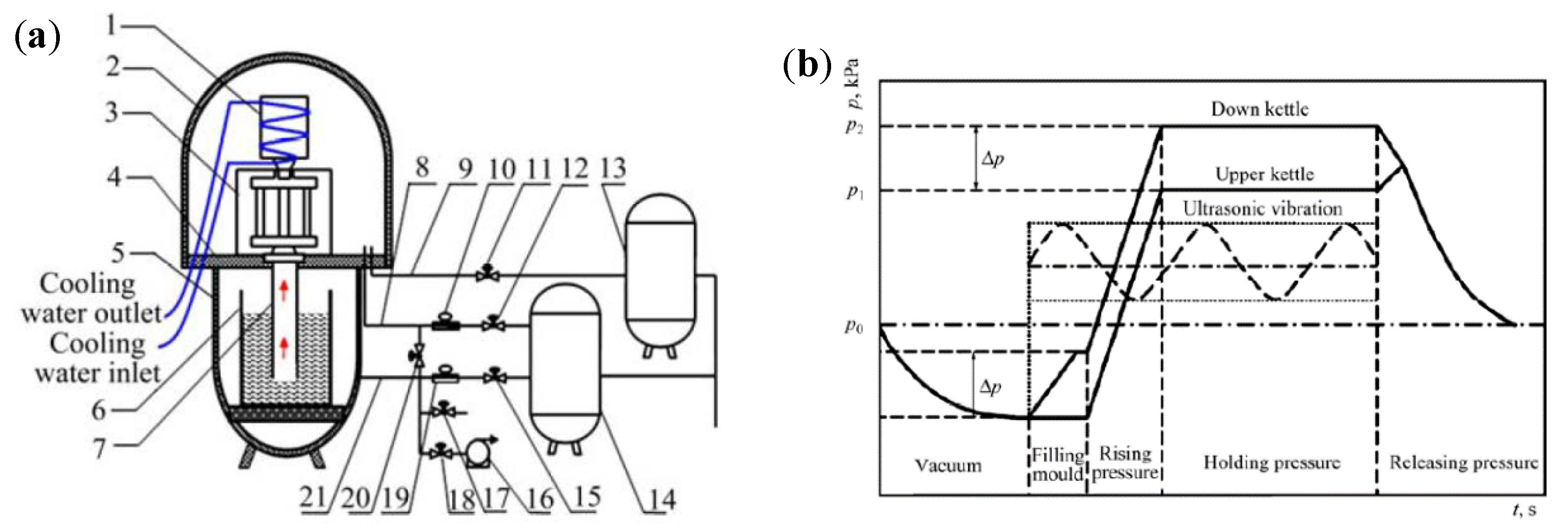

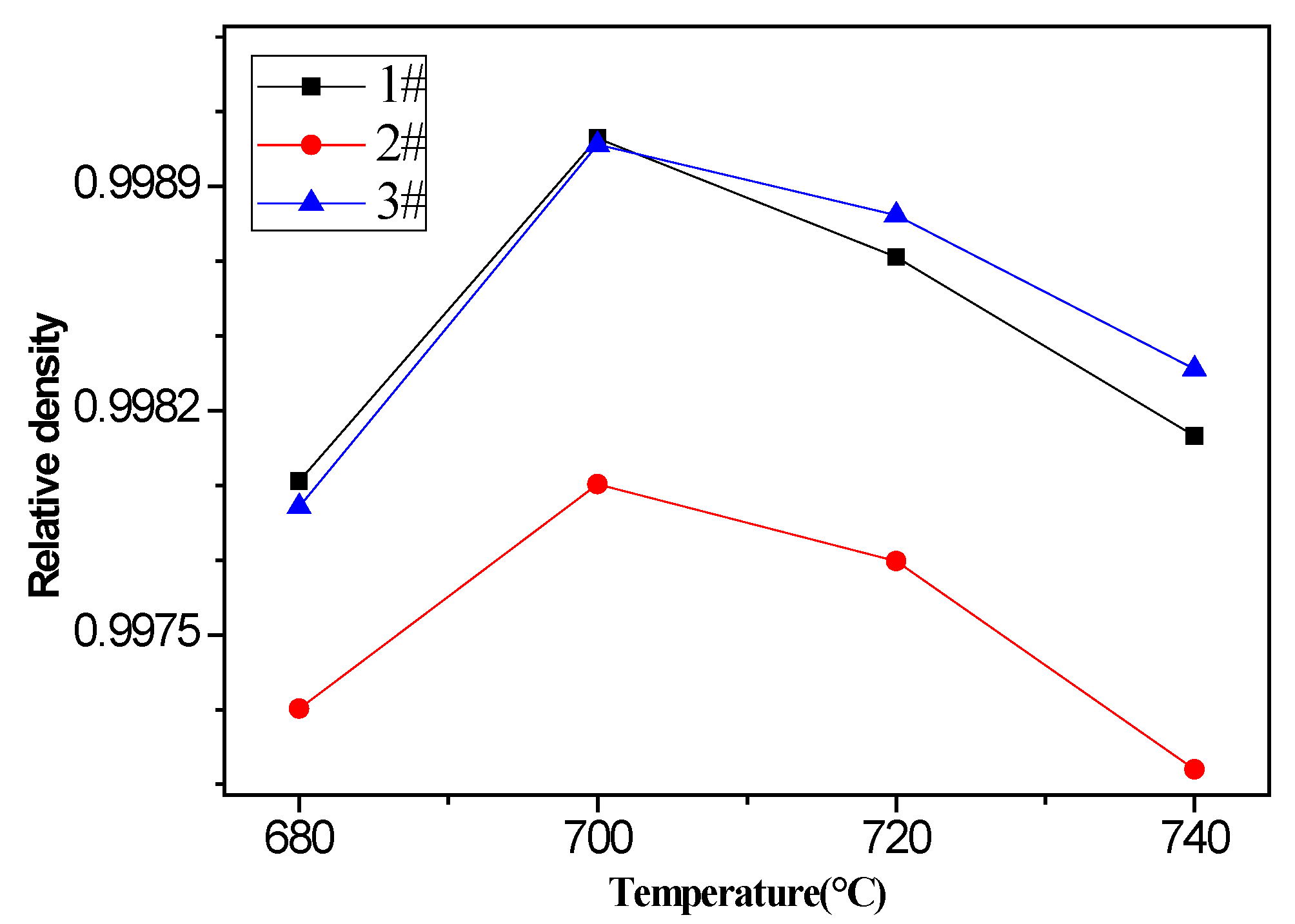
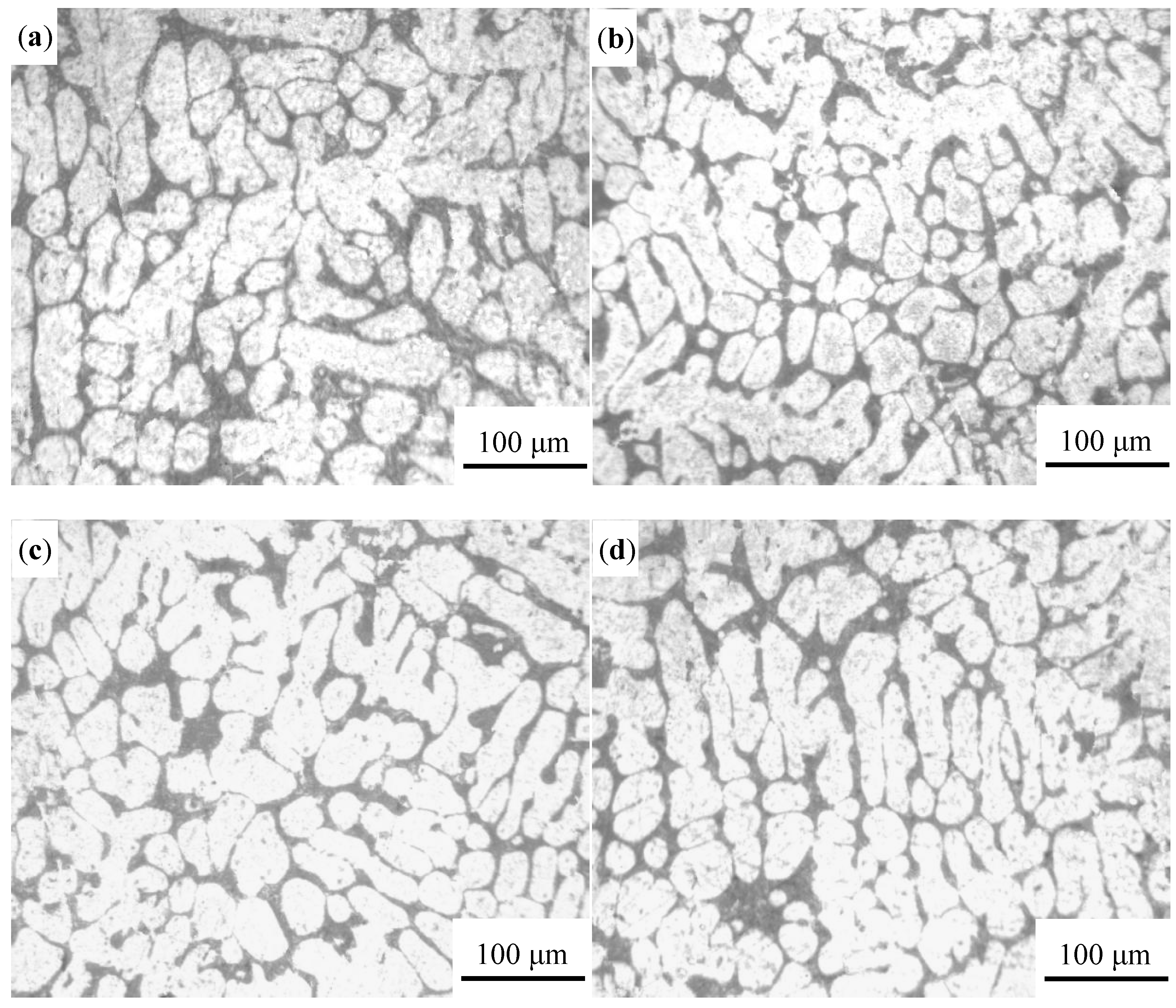

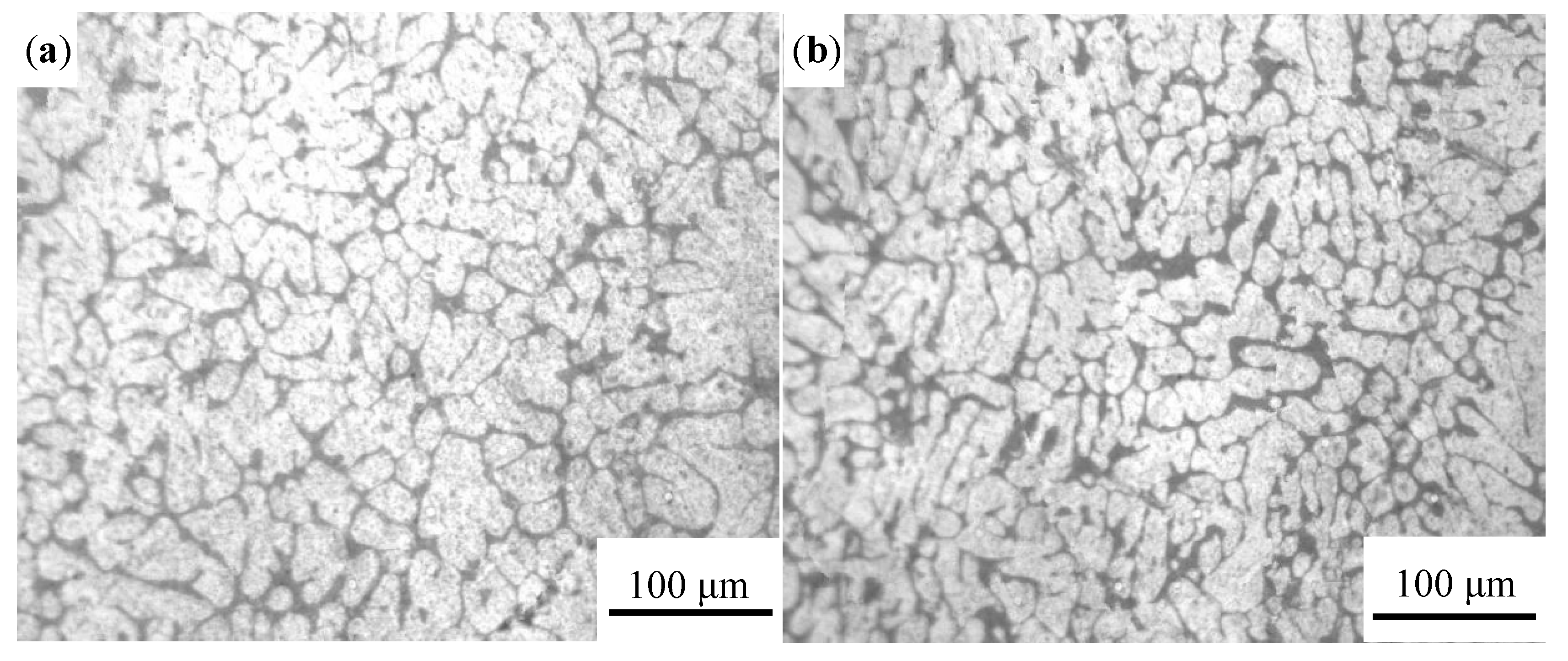
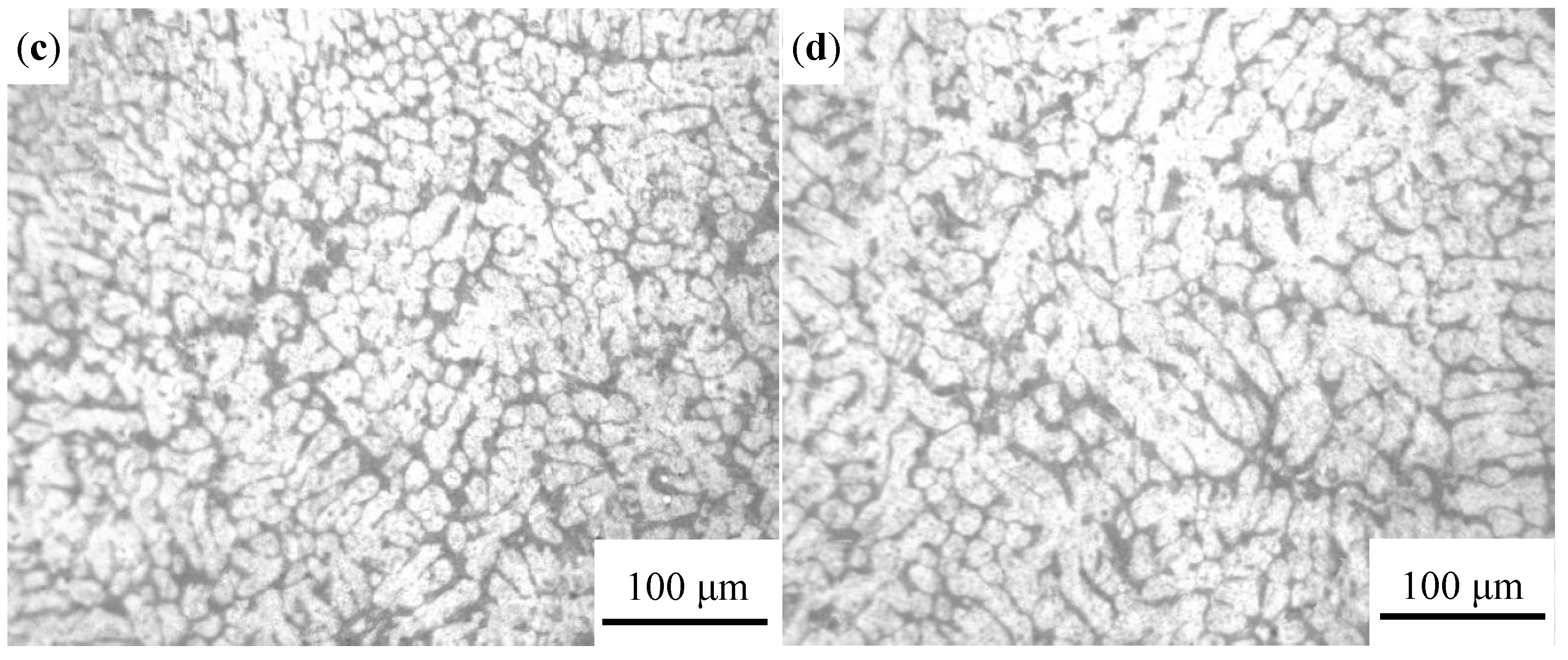
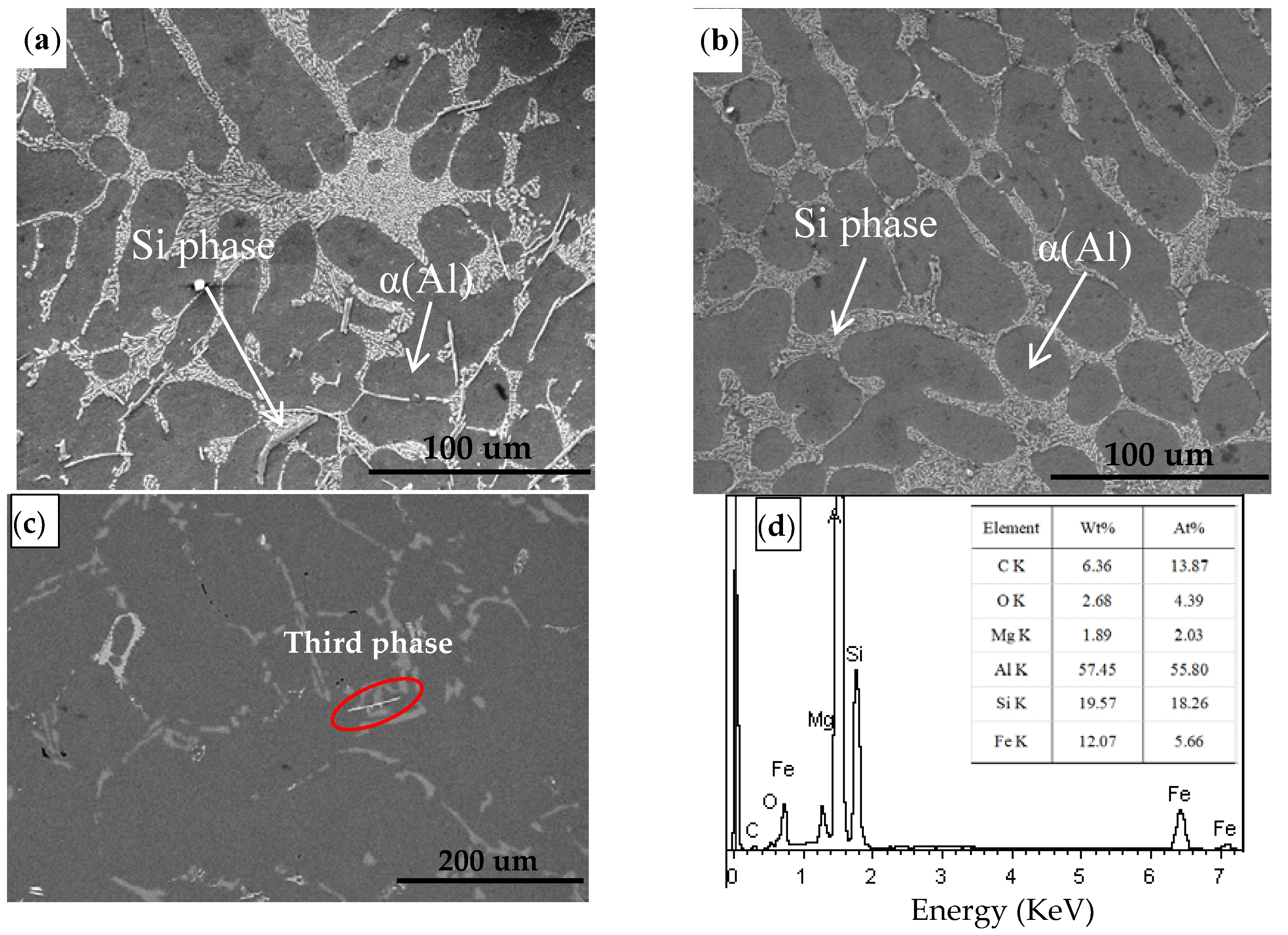

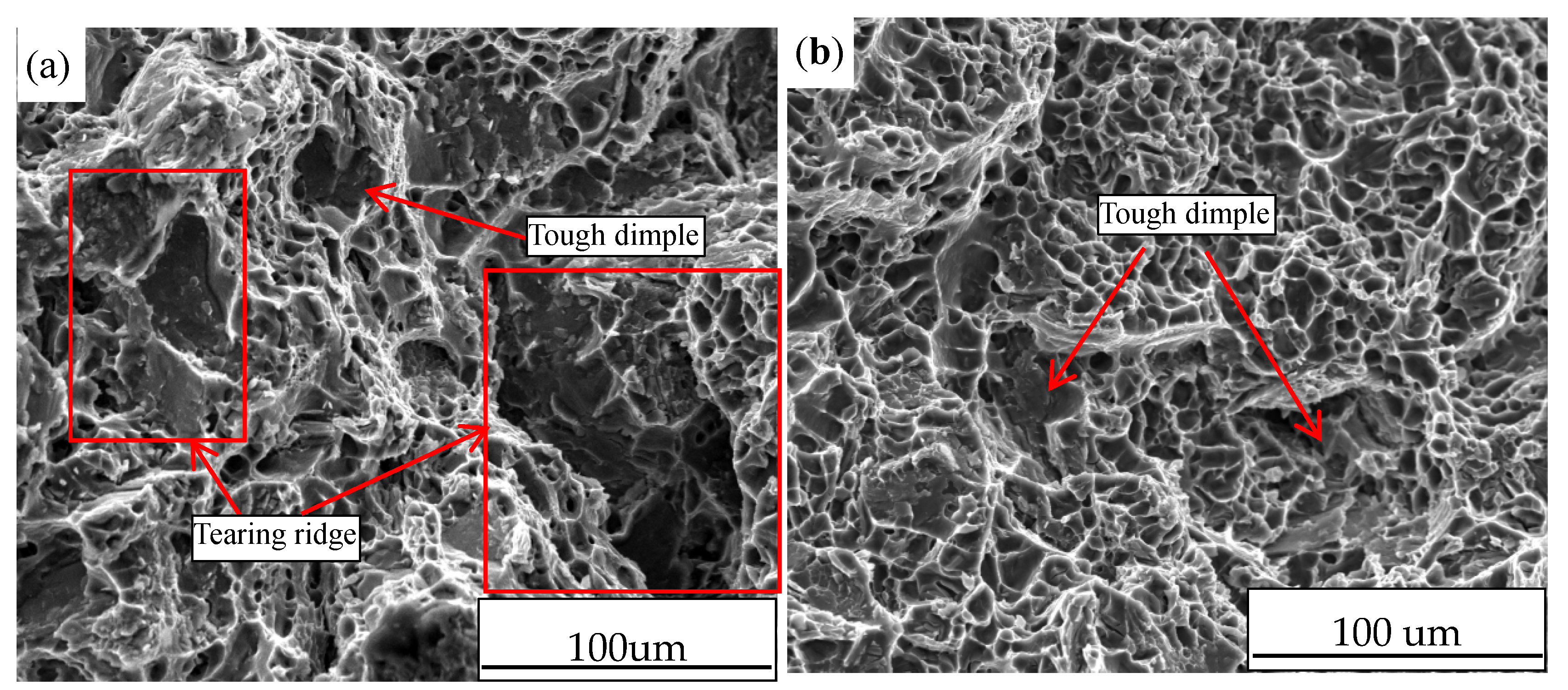
| Si | Mg | Fe | Ti | Be | Zn | Cu | Al |
|---|---|---|---|---|---|---|---|
| 6.89 | 0.52 | 0.12 | 0.13 | 0.04–0.07 | <0.1 | <0.01 | Bal. |
| Ultrasonic Temperature (°C) | Vacuum Degree (kPa) | Pressure Difference (kPa) | Solidification Pressure (kPa) | Time of Holding Pressure (s) | Ultrasonic Power (W) |
|---|---|---|---|---|---|
| 680 | 20 | 35 | 350 | 200 | 600 |
| 700 | |||||
| 720 | |||||
| 740 |
| Temperature/°C | 680 | 700 | 720 | 740 |
| Tensile Strength/MPa | 291.9 ± 2.5 | 314.9 ± 2.7 | 307.5 ± 2.1 | 293.4 ± 3.3 |
| Elongation/% | 4.84 ± 0.13 | 5.38 ± 0.15 | 5.15 ± 0.12 | 4.88 ± 0.21 |
| Temperature/°C | 680 | 700 | 720 | 740 |
| Tensile Strength/MPa | 308.9 ± 3.1 | 318.8 ± 3.5 | 327 ± 4.0 | 310.3 ± 3.8 |
| Elongation/% | 4.83 ± 0.10 | 5.25 ± 0.15 | 5.57 ± 0.11 | 4.89 ± 0.19 |
© 2020 by the authors. Licensee MDPI, Basel, Switzerland. This article is an open access article distributed under the terms and conditions of the Creative Commons Attribution (CC BY) license (http://creativecommons.org/licenses/by/4.0/).
Share and Cite
Lu, G.; Huang, P.; Yan, Q.; Xu, P.; Pan, F.; Zhan, H.; Chen, Y. Optimizing the Microstructure and Mechanical Properties of Vacuum Counter-Pressure Casting ZL114A Aluminum Alloy via Ultrasonic Treatment. Materials 2020, 13, 4232. https://doi.org/10.3390/ma13194232
Lu G, Huang P, Yan Q, Xu P, Pan F, Zhan H, Chen Y. Optimizing the Microstructure and Mechanical Properties of Vacuum Counter-Pressure Casting ZL114A Aluminum Alloy via Ultrasonic Treatment. Materials. 2020; 13(19):4232. https://doi.org/10.3390/ma13194232
Chicago/Turabian StyleLu, Gang, Pengpeng Huang, Qingsong Yan, Pian Xu, Fei Pan, Hongxing Zhan, and Yisi Chen. 2020. "Optimizing the Microstructure and Mechanical Properties of Vacuum Counter-Pressure Casting ZL114A Aluminum Alloy via Ultrasonic Treatment" Materials 13, no. 19: 4232. https://doi.org/10.3390/ma13194232
APA StyleLu, G., Huang, P., Yan, Q., Xu, P., Pan, F., Zhan, H., & Chen, Y. (2020). Optimizing the Microstructure and Mechanical Properties of Vacuum Counter-Pressure Casting ZL114A Aluminum Alloy via Ultrasonic Treatment. Materials, 13(19), 4232. https://doi.org/10.3390/ma13194232




